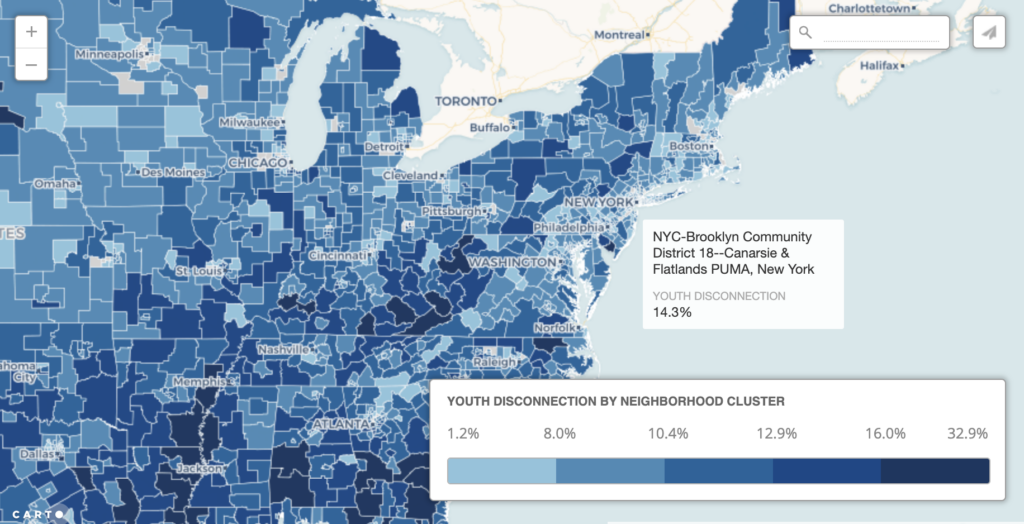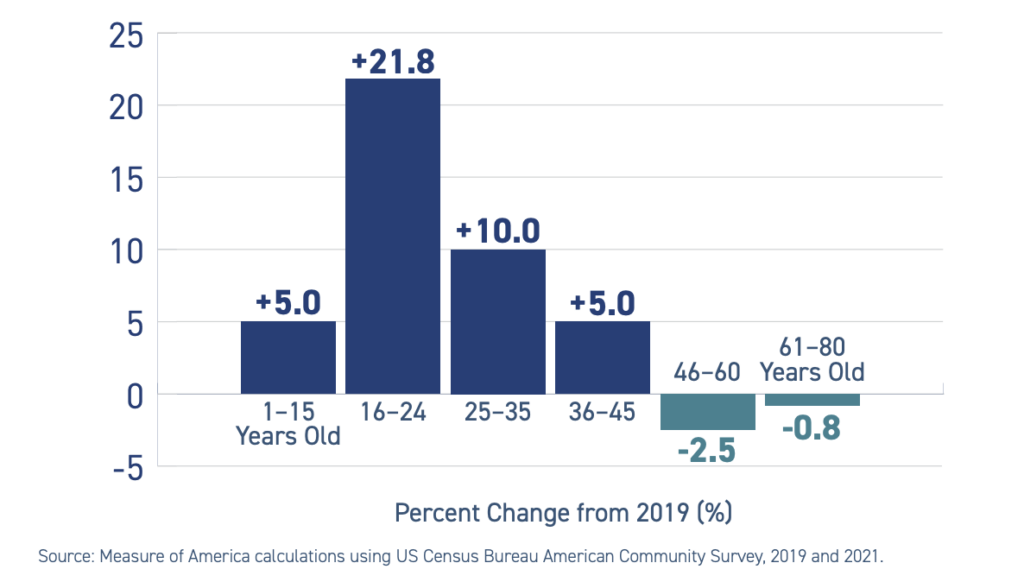The Measure of America program uses granular data and effective communication to enable stakeholders to better understand the problem of youth disconnection, and to develop policies to reduce the share of young people neither working nor in school.
The US youth disconnection rate—the share of young adults aged 16 to 24 neither working nor in school—decreased between 2010 and 2019, and after a spike during Covid, has returned to its 2019 level: 10.9 percent of youth, or some 4,343,600 people. But the pattern of young people not connected to educational institutions or the labor market varies widely by place, race and ethnicity, and gender. For instance, the disconnection rate for Native American youth is 23.5 percent, but for Asian young people, it is 6.9 percent.
SSRC’s Measure of America (MOA) program was the first US research initiative to standardize the measurement of youth disconnection, and has been calculating it annually since 2012. Recently, their findings were used to frame the Opening Doors For Youth Act, a $6.75 billion investment in America’s youth that was introduced in the US House of Representatives and Senate. Core elements of this bill were incorporated into the bipartisan Stronger Workforce for America Act, designed to reform and reauthorize the Workforce Innovation and Opportunity Act of 2016. This bill passed the House easily on a bipartisan basis in April of 2024.
We sat down with Kristen Lewis, director and co-founder of Measure of America, to learn about how MOA’s research helps achieve shared understanding and spurs philanthropic and legislative action.

Can you explain why this particular group is important to policymakers and how you came to track it?

Kristen Lewis
Sure. First, I have to say that we’re not the only group to draw attention to this issue, but we’ve been able to shed more light on it with data, and that’s enabling policymakers, philanthropies, and service providers to craft better ways to address the needs of disconnected youth (also called “opportunity youth”). The fact that we’re losing people from both the educational pipeline and labor force is really important because those are two of the basic functions of a government, or any society—educating young people and getting them into jobs.
All young people deserve the chance to make decisions about their own futures and to have the capabilities they need to seize opportunities, but right now, the distribution of these opportunities in America is profoundly unequal. Aside from the moral reasons for improving the lives of others, there’s a substantial economic and community benefit to ensuring that young adults are not disconnected from work and school. Our research shows that disconnected youth earn, on average, $38,400 less each year than their connected counterparts when they reach their thirties, and solving this problem could save upwards of $55 billion in public expenditures annually. This return-on-investment calculation has been important to policymakers to justify legislation that addresses this issue.
The root of this work is the human development and capabilities approach, the brainchild of Nobel Laureate Amartya Sen. Human development is about improving people’s well-being and expanding their choices and opportunities to live freely chosen lives of value; this approach informed the creation of the United Nations Development Programme and their annual Human Development reports. Measure of America created the first-ever human development report for a wealthy, developed nation in 2008, and this led directly to a research focus on youth disconnection. The period of young adulthood is critical in developing the capabilities required to live a good life: knowledge and credentials, social skills and networks, a sense of mastery and agency, an understanding of one’s strengths and preferences, and the ability to handle stressful events and regulate one’s emotions, to name just a few. Measure of America is concerned with addressing youth disconnection, because it stunts human development, closing off some of life’s most rewarding and joyful paths and leading to a future of limited horizons and unrealized potential.

Sometimes lots and lots of detailed statistics can turn people off or be hard to digest, but the recent justification for legislation cites your work in detail over and over. What do you think created an appetite for numbers on this issue?

Kristen Lewis
I can’t say for sure, but when we started, we kept hearing this ghost statistic repeated over and over again, that 6.8 million youth weren’t in school or working. When we tried to track down the source, we found that it wasn’t based on anything rigorous. If you’re going to try to fix a problem, you need to know how big the problem is. So we started looking at the US as a whole, using data from the US Census Bureau’s annual American Community Survey, and then we started producing reports that ranked states, metro areas, and congressional districts.
Once we had that kind of granular data, we got a lot of interest from cities who were curious about how they were faring. San Diego wanted to know what share of this population were mothers, what were their ages, and more detailed statistics on their city. A community foundation in Louisiana wanted to know more about the problem there so they could better direct their local grantmaking at community organizations best positioned to help. We just released a report on Newark, New Jersey, and are about to release another on Houston, Texas. I’m encouraged to see the appetite for the data that will help cities target policies like summer jobs and vocational training to the neighborhoods and people who need them the most.

We’ve also invested heavily in making the research very easy to understand. We have an interactive web tool that lets you explore down to the neighborhood level, and we produce reports and visualizations that help people who might not have much experience working with data to clearly understand disconnection rates in their area. When we launch reports, we usually have a webinar or in-person event where we walk the local stakeholders through what we’ve found for their area and make sure all their questions are answered.

One of the most interesting findings of our latest national youth disconnection report was that the share of young adults with at least one disability increased sharply between 2019 and 2021. In particular, the cognitive disability rate for young adults ages 16–24 increased 21.8 percent from 2019, far more sharply than it did for other age groups; Covid-19 or Covid-associated mental health challenges are the likely culprit.

Youth disconnection is a national problem, and we’ve seen that the kind of solutions that might work in Newark might not work in San Diego, or in a rural, agricultural region. This is reflected in the design of the acts in the House and Senate, which have flexible funding for the types of support needed. I hope that, regardless of what happens in Congress, we will be able to continue to expand our work to support the efforts of local government and community organizations who can use data to help get young people back into school and the workforce.
